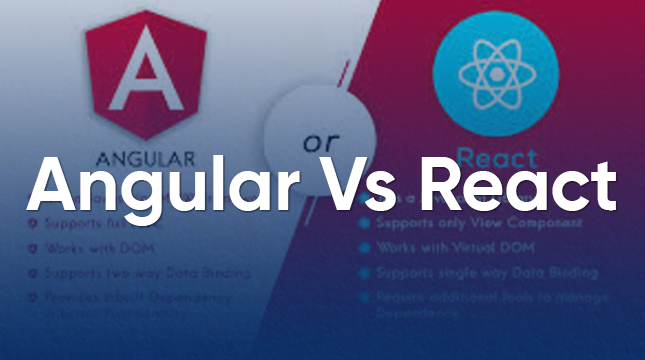This website uses cookies so that we can provide you with the best user experience possible. Cookie information is stored in your browser and performs functions such as recognising you when you return to our website and helping our team to understand which sections of the website you find most interesting and useful.
Difference Between Angular vs React ?

Choosing the right technology is crucial in the ever-evolving landscape of front-end development. It’s like picking your weapon for a digital duel – a framework or library that empowers you to craft exceptional user interfaces (UIs) and interactive web experiences. In this battle royale, two contenders stand out: Angular and React. But which one deserves a place in your development arsenal?
In the Ring: A Side-by-Side Comparison
Let’s dissect the core differences between these titans.
-
Framework vs Library: Angular’s Structure vs React’s Flexibility
Angular is a full-fledged framework, offering a comprehensive structure and a collection of tools for building web applications. Imagine it as a pre-built suit of armor, complete with everything you need to jump into development. React, on the other hand, is a JavaScript library that focuses on UI components. Think of it as a customizable weapon – you pick the parts you need and integrate them with other tools. This flexibility allows for more tailored development, but requires a deeper understanding of the underlying JavaScript ecosystem.
-
Data Binding Done Differently: Two-Way vs One-Way Streets
How data flows between your application’s model and the user interface is a critical aspect. Angular utilizes two-way data binding, meaning changes in the UI automatically reflect in the underlying data, and vice versa. This simplifies development, but can get complex in large applications. React, on the other hand, employs one-way data binding. Changes flow from the data to the UI, but not the other way around. This necessitates a more manual approach but offers greater control and potential performance benefits.
-
Performance Perks: Speed Demons or Steady Stallions?
Both Angular and React are known for their performance, but in slightly different ways. Angular, with its pre-built structure, might have a slight edge in initial load times for simple applications. However, React’s virtual DOM (a lightweight representation of the real DOM) allows for faster updates and rendering, making it a strong contender for complex, data-driven applications.
-
Learning Curve: Scaling the Mountain of Knowledge
If you’re new to front-end development, React might seem more approachable due to its reliance on vanilla JavaScript. However, Angular, with its structured approach, can be easier to learn if you’re familiar with object-oriented programming concepts. Ultimately, both require dedication and practice to master.
Deep Dive into Angular: Power and Structure
Let’s delve into the specific features that make Angular a compelling choice.
-
Starring TypeScript: Stepping Up from JavaScript
Angular leverages TypeScript, a superset of JavaScript that adds optional static typing. This improves code readability, maintainability, and helps catch errors early in the development process. Imagine it as a suit of armor forged from a stronger material, offering superior protection.
-
Dependency Injection: A Magic Act for Developers
Dependency injection is a core principle in Angular. It allows developers to specify dependencies explicitly, making code more modular and easier to test. Think of it as a magic trick where components receive exactly what they need, without the developer needing to manage complex interactions manually.
-
Components: Building Blocks of Angular Applications
Angular applications are built using reusable components, each with its own template and logic. This modular approach promotes code organization and maintainability. Imagine building your application with pre-fabricated building blocks, ensuring consistency and efficiency.
-
Directives: Adding Behavior to Your Angular Arsenal
Directives are special instructions that manipulate the DOM or add behavior to components. They extend the functionality of your Angular application without cluttering your component code. Think of them as special tools in your developer’s belt, allowing you to fine-tune the behavior of your UI elements.
React: The Agile Frontrunner
Now, let’s explore what makes React such a popular choice for front-end development.
-
JSX: A Familiar Syntax for Building UIs
React utilizes JSX, a syntax extension for JavaScript that allows you to write HTML-like structures within your code. This familiarity makes it easier for developers with a background in HTML to learn and adopt React. Imagine using a weapon with controls that feel intuitive and comfortable.
-
Virtual DOM: Rendering Without the Heavyweight Champion
React’s virtual DOM is a lightweight representation of the real DOM. When changes occur in the data, React efficiently updates the virtual DOM and then applies only the minimal changes necessary to the actual DOM. This significantly improves performance, especially in dynamic applications. Think of it as a lightweight training sword that allows for faster, more precise strikes.
-
Reusable Components: The Legos of React Development
Imagine building complex UIs with Lego bricks – each component a reusable block that can be combined to create intricate structures. React’s focus on composable components makes it a favorite for building large-scale, single-page applications (SPAs).
-
React Ecosystem: A Universe of Third-Party Libraries
React’s core library is lightweight and focused on UI components. However, its vast ecosystem of third-party libraries provides additional functionalities for routing, state management, testing, and more. This flexibility allows developers to tailor their development environment to their specific needs. Imagine having a vast armory at your disposal, with specialized weapons and tools for every situation.
Read More : The Ultimate Guide To Progressive Web Apps- An Explicit Look
Choosing Your Champion: When to Opt for Angular or React
Now that you understand the core differences, here’s how to pick the right tool for the job.
-
Project Size and Complexity: Gearing Up for Large-Scale Battles
For large-scale enterprise applications with complex features and a need for strict structure, Angular might be a better choice. Its built-in features and enforcements can streamline development and ensure code maintainability over time.
-
Team Expertise: Leveraging Existing Knowledge
If your development team is already familiar with TypeScript and object-oriented programming concepts, Angular might be a smoother transition. Conversely, a team with strong JavaScript skills might find React’s approach more natural.
-
Considering the Future: Staying Ahead of the Curve
Both Angular and React are actively maintained and constantly evolving. However, React’s larger community and emphasis on flexibility might give it a slight edge in terms of staying ahead of the latest trends and advancements.
Beyond the Ring: The Final Verdict
There’s no single winner in the Angular vs React battle. The best choice depends on your specific project requirements, team expertise, and long-term vision.
-
It’s Not Always Black and White: Exploring Other Options
While Angular and React are dominant forces, there are other frameworks and libraries worth considering, such as Vue.js or Svelte. Evaluating all options ensures you select the most suitable technology for your project.
-
The Importance of Project Needs: Choosing the Right Tool
Remember, the best technology is the one that empowers you to build the best possible application. Don’t get caught up in framework wars – focus on finding the tool that best suits your project’s needs.

Let's Start Your Project
Get free consultation for your digital product idea to turn it into reality!
Get Started






